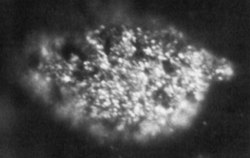Berkelium
The major isotope of berkelium, berkelium-249, is synthesized in minute quantities in dedicated high-flux nuclear reactors, mainly at the Oak Ridge National Laboratory in Tennessee, USA, and at the Research Institute of Atomic Reactors in Dimitrovgrad, Russia. The production of the second-important isotope berkelium-247 involves the irradiation of the rare isotope curium-244 with high-energy alpha particles.
Just over one gram of berkelium has been produced in the United States since 1967. There is no practical application of berkelium outside of scientific research which is mostly directed at the synthesis of heavier transuranic elements and transactinides. A 22 milligram batch of berkelium-249 was prepared during a 250-day irradiation period and then purified for a further 90 days at Oak Ridge in 2009. This sample was used to synthesize the element ununseptium for the first time in 2009 at the Joint Institute for Nuclear Research, Russia, after it was bombarded with calcium-48 ions for 150 days. This was a culmination of the Russia–US collaboration on the synthesis of elements 113 to 118.
Berkelium is a soft, silvery-white, radioactive metal. The berkelium-249 isotope emits low-energy electrons and thus is relatively safe to handle. However, it decays with a half-life of 330 days to californium-249, which is a strong and hazardous emitter of alpha particles. This gradual transformation is an important consideration when studying the properties of elemental berkelium and its chemical compounds, since the formation of californium brings not only chemical contamination, but also self-radiation damage, and self-heating from the emitted alpha particles.
Occurrence
All berkelium isotopes have a half-life far too short to be primordial. Therefore, all primordial berkelium, that is, berkelium present on the Earth during its formation, has decayed by now.
On Earth, berkelium is mostly concentrated in certain areas, which were used for the atmospheric nuclear weapons tests between 1945 and 1980, as well as at the sites of nuclear incidents, such as the Chernobyl disaster, Three Mile Island accident and 1968 Thule Air Base B-52 crash. Analysis of the debris at the testing site of the first U.S. hydrogen bomb, Ivy Mike, (1 November 1952, Enewetak Atoll), revealed high concentrations of various actinides, including berkelium. For reasons of military secrecy, this result was published only in 1956.
Nuclear reactors produce mostly, among the berkelium isotopes, berkelium-249. During the storage and before the fuel disposal, most of it beta decays to californium-249. The latter has a half-life of 351 years, which is relatively long when compared to the other isotopes produced in the reactor, and is therefore undesirable in the disposal products.
A few atoms of berkelium can be produced by neutron capture reactions and beta decay in very highly concentrated uranium-bearing deposits, thus making it the rarest naturally occurring element.
| Symbol | Bk | |
| Atomic Number | 97 | |
| Atomic Weight | 247.0703 | |
| Oxidation States | +3, +4 | |
| Electronegativity, Pauling | 1.3 | |
| State at RT | Solid, Metal | |
| Melting Point, K | ||
| Boiling Point, K |
Appearance and Characteristics of Berkelium
Harmful effects:
Berkelium is harmful due to its radioactivity.
Characteristics:
- Berkelium is a silvery-white highly radioactive metal.
- It is chemically reactive, oxidizing slowly in air.
- The oxidation may be slow because of the initial formation of a thin protective oxide layer.
- Berkelium metal is dimorphic: double hexagonal close packed at room temperature and face centered cubic at higher temperatures.
- The metal dissolves rapidly in aqueous mineral acids, liberating hydrogen gas and forming Bk (III) in solution.
- Bk (III) ions are green in most mineral acid solutions.
- Bk (IV) ions are yellow in HCl solution.
Uses of Berkelium
- Berkelium is of scientific research interest only.
- Berkelium-249 is used as a target material for the production of heavier actinides such as lawrencium-260.
